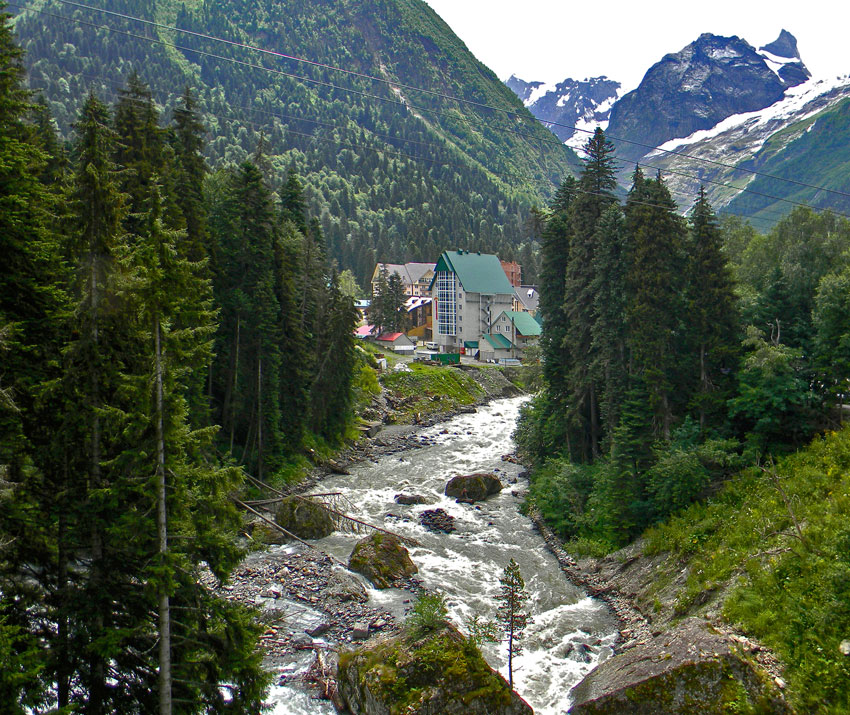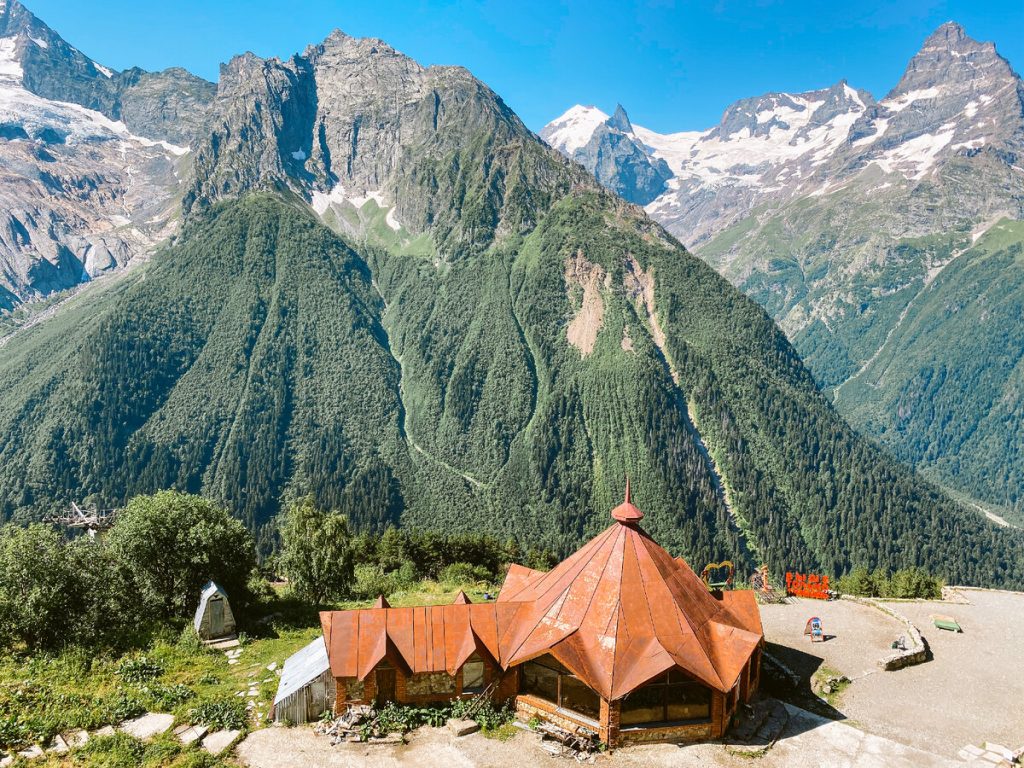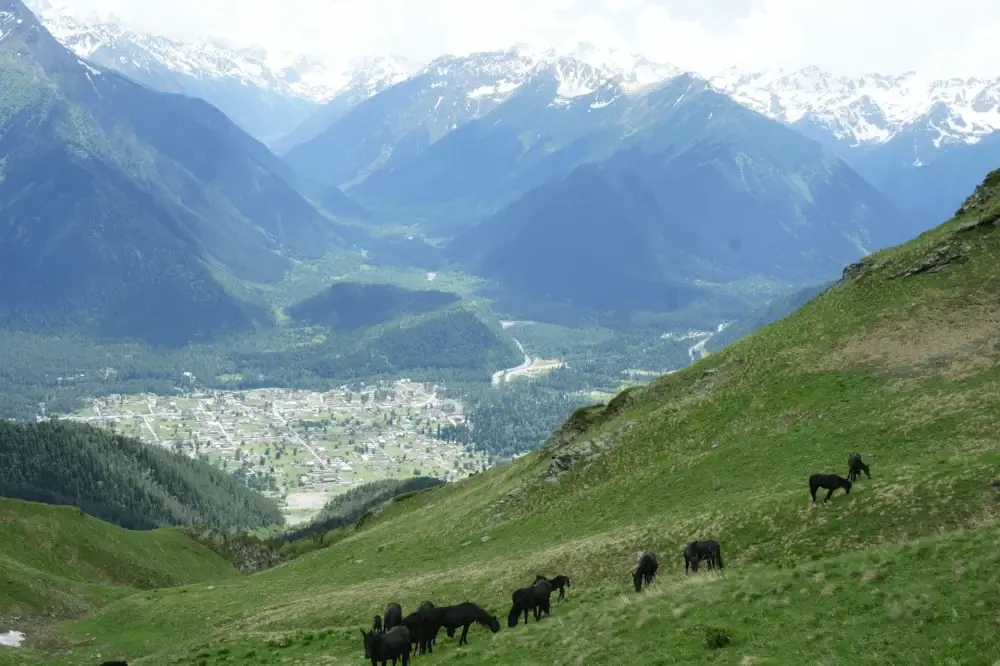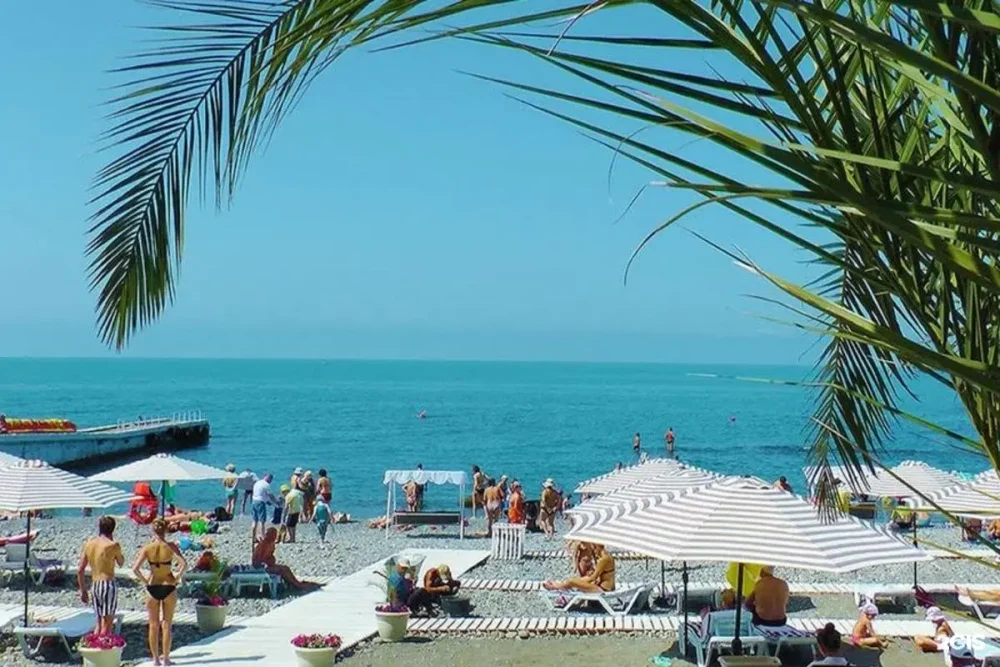Dombai is a picturesque mountain resort that attracts travellers with its unique landscape, picturesque nature and a variety of active recreation options. It is located in Karachay-Cherkessia and is one of the most popular tourist destinations in the country.
The resort impresses with its breathtaking panorama, beautiful peaks, multi-stage waterfalls and transparent lakes. However, the attraction of this place lies not only in nature. Architecture, cable cars and national traditions form its special atmosphere. Before visiting, it is important to determine what to see in Dombai and which of its attractions deserve attention in the first place.
Dombai – a mountain wonderland
The mountain system of Dombai is astonishing in scale. The peaks reach heights of over 4,000 metres, creating breathtaking views. Among the most famous are Belalakaya, Alibek and Sulakhat.
Each peak has its own peculiarities: Belalakaya resembles a pyramid with its silhouette. Alibek attracts with its glacier routes, and Sulakhat is famous for its breathtaking views of valleys and gorges.
The sights of Dombai include: mountain peaks, passes, which offer fabulous views of glaciers and rock massifs.
The climate of the region is characterised by sharp temperature changes. In summer the air warms up to +25C, but the nights remain cool. In winter, the temperature regime varies from -5C to -20C. This creates perfect conditions for skiing and snowboarding. Snow falls in November and covers the ground with a dense layer. It does not melt until the end of April. Thanks to this, the resort attracts fans of active holidays in the winter season.
Rest in Dombai in summer opens before travellers a lot of activities:
- hiking routes along mountain trails with breathtaking scenery;
- Rafting on rushing rivers descending from glaciers;
- mountaineering on difficult rock routes;
- Cable car rides for local sightseeing.
The winter season is rich in entertainment:
- ski slopes of varying difficulty, suitable for both beginners and professionals;
- snowmobile riding on snowy expanses;
- ice fishing in mountain glacial lakes.
Dombai is a place where nature reveals its power and beauty at any time of the year.
Dombai peaks, lakes and waterfalls: nature that takes your breath away
 Let’s list the sights of Dombai that deserve the attention of active travellers.
Let’s list the sights of Dombai that deserve the attention of active travellers.
Legendary mountains of Dombai
The mountain ranges create the extraordinary relief of the region. Mountains here are not only a symbol of height, but also an object for research. Tourists can climb the Alibek glacier. It is one of the largest in these places. You can also hike to the Chuchkhur Pass. High-altitude trails offer unforgettable landscapes, making travelling in this region special.
Dombay lakes – turquoise mirrors at the height of clouds
There are dozens of mountain lakes in the region. Among them is the famous Tumanly Kel, surrounded by alpine meadows and peaks. Its depth reaches 30 metres, and the water changes shades from deep blue to emerald. The lakes were formed as a result of glacial activity, and each of them has its own unique ecosystem.
Dombai waterfalls: natural cascades of power and beauty
There are many waterfalls in the region, but the Alibek and Chuchkhur waterfalls are particularly impressive. They are located in mountain gorges and attract with a powerful flow of water, especially in spring. The waterfalls are distinguished by their height and picturesqueness, becoming key points of travellers’ routes.
Wonders of the Teberda Reserve
The Teberdinsky Reserve is one of the most protected natural corners of Russia, occupying an area of over 85,000 hectares. It is home to more than 130 species of mammals, including rare snow leopards, Caucasian red deer and aurochs. Trout and grayling can be found in the waters of the protected rivers, and eagles and bearded eagles soar in the sky. The plant world counts about 1200 species of flora, among which are endemics listed in the Red Book.
The reserve offers tourists equipped eco-trails, observation platforms and special routes. They allow you to observe wildlife in natural conditions.
Popular routes to visit:
- Klukhor Lake is a picturesque place of the reserve at an altitude of 2700 metres.
- Mussa-Achitara Mountain is a viewing platform with a breathtaking view of the whole Dombai.
- Alibek waterfall is one of the most powerful cascading waterfalls in the region.
- A visit to the reserve is an opportunity to see the sights of Dombai in all its glory. To feel the spirit of untouched forests and alpine meadows, to feel harmony with the pristine nature of the Caucasus.
Dombay cable car: height, adrenaline, views
The panoramic ascent to a height of 3168 metres is the most spectacular way to experience the splendour of the Caucasus Mountains. The Dombai cable car consists of three stages, each offering extraordinary views and opportunities. Modern cabins with panoramic windows allow you to admire the breathtaking scenery, making the journey as comfortable as possible.
Route Features:
- the first stage – the ascent to the height of 2277 metres. An ideal place for walking and visiting cosy local cafes with observation decks;
- second stage – reaching an altitude of 3012 metres. Impressive panoramas of glaciers and key peaks of Dombai;
- third stage – ascent to the height of 3168 metres, the final point of the route. Here a panoramic view of the whole Dombai massif opens up.
In winter, the cable car is actively used by skiers, providing quick access to slopes of varying difficulty. In summer, the trip becomes an unforgettable adventure.
From the height you can see the sights of Dombai: famous mountain ranges, gorges and snowy peaks.
Several hiking routes are available for tourists, starting from different levels of the station. Some trails lead to high-mountain lakes and viewpoints. Here you can have a great rest, enjoy the scenery and photograph panoramas of the Caucasus Mountains.
Conclusion
 The Russian resort village is a place where you can experience harmony with nature, breathe crystal clear air and enjoy landscapes that can impress the most sophisticated travellers. Dombai sights include: natural and cultural objects that create a unique atmosphere of unity with the mountains.
The Russian resort village is a place where you can experience harmony with nature, breathe crystal clear air and enjoy landscapes that can impress the most sophisticated travellers. Dombai sights include: natural and cultural objects that create a unique atmosphere of unity with the mountains.
Travelling to this region is an opportunity to see the Caucasus in all its glory. To feel the breath of centuries-old glaciers and experience the delight of encounters with untouched nature.
 en
en  ar
ar  de
de  es
es  fr
fr  nl
nl  hi
hi  ru
ru  it
it  pt
pt  el
el 










